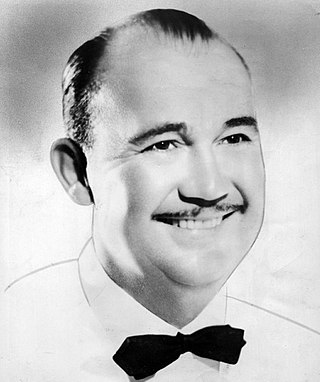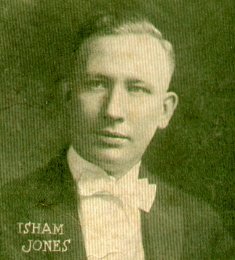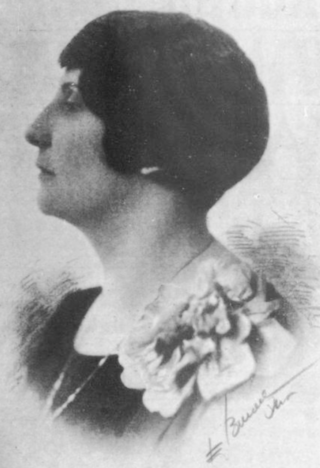
Louis Daniel Armstrong, nicknamed "Satchmo", "Satch", and "Pops", was an American trumpeter and vocalist. He was among the most influential figures in jazz. His career spanned five decades and several eras in the history of jazz. He received numerous accolades including the Grammy Award for Best Male Vocal Performance for Hello, Dolly! in 1965, as well as a posthumous win for the Grammy Lifetime Achievement Award in 1972, and induction into the National Rhythm & Blues Hall of Fame in 2017.

Paul Samuel Whiteman was an American bandleader, composer, orchestral director, and violinist.

Isham Edgar Jones was an American bandleader, saxophonist, bassist and songwriter.

"The Saint Louis Blues" is a popular American song composed by W. C. Handy in the blues style and published in September 1914. It was one of the first blues songs to succeed as a pop song and remains a fundamental part of jazz musicians' repertoire. Benny Goodman, Louis Armstrong, Cab Calloway, Bing Crosby, Bessie Smith, Eartha Kitt, Count Basie, Glenn Miller, Guy Lombardo, Peanuts Hucko, and the Boston Pops Orchestra are among the artists who have recorded it. The song has been called "the jazzman's Hamlet". Composer William Grant Still arranged a version of the song in 1916 while working with Handy.

Dudley Buck was an American composer, organist, and writer on music. He published several books, most notably the Dictionary of Musical Terms and Influence of the Organ in History, which was published in New York City in 1882.
"They Can't Take That Away from Me" is a 1937 popular song with music by George Gershwin and lyrics by Ira Gershwin. It was introduced by Fred Astaire in the 1937 film Shall We Dance and gained huge success.

"Tiger Rag" is a jazz standard that was recorded and copyrighted by the Original Dixieland Jass Band in 1917. It is one of the most recorded jazz compositions. In 2003, the 1918 recording of "Tiger Rag" was entered into the U.S. Library of Congress National Recording Registry.
"Pennies from Heaven" is a 1936 American popular song with music by Arthur Johnston and lyrics by Johnny Burke. It was introduced by Bing Crosby with Georgie Stoll and his Orchestra in the 1936 film of the same name.
Women in jazz have contributed throughout the many eras of jazz history, both as performers and as composers, songwriters and bandleaders. While women such as Billie Holiday and Ella Fitzgerald were famous for their jazz singing, women have achieved much less recognition for their contributions as composers, bandleaders and instrumental performers. Other notable jazz women include piano player Lil Hardin Armstrong and jazz songwriters Irene Higginbotham and Dorothy Fields.
Harry David Kerr was an American songwriter, lyricist, author, and lawyer. Kerr became active in music at age 15 (1895). The practice of law had been his prime avocation until 1920, when he decided to focus on songwriting. But he still continued to use his legal training in music. In 1922, while living in New York City, Kerr prepared the incorporation documents for the American Society of Composers, Authors and Publishers (ASCAP), of which he had become one of 90 charter members at its founding in 1914.
Lola Carrier Worrell was an American composer who wrote instrumental music, songs, and at least one piece for musical theatre. Born in St. Johns, Michigan, she studied music with Carlos Sobimo, Francis Hendricks and Horace E Tureman. Lola married Edward S Worrell Jr. on January 12, 1891, and they had three daughters. The family maintained homes in New York and Colorado, where Lola founded the Denver American Music Society and served as its first president. She also organized and served as the pianist for the Chamber Music Quintet of Denver. Along with other musicians such as Caroline Holme Walker, Lola maintained a studio at Brinton Terrace in Denver, where she coached pianists, singers, and young composers. She gave recitals with contralto Louis Merten, whom she accompanied on piano. In addition to her work as a musician, Lola filed patents for dolls she developed in 1922, 1924, and 1925. The 1925 patent application described the doll as a "flapper doll." Her compositions included:
Helen Searles Westbrook was an American composer and organist who appeared with Chicago Symphony.

Cornelia Townsend was an American song composer who published most of her music under the name Kate Vanderpoel.
Anne Gannet Stratton Miller Holden was an American composer who is best remembered today for her song “Boats of Mine,” which was widely performed and recorded during her lifetime. She published her music under the name Anne Stratton.
Rosalie Balmer Smith Cale was an American pianist and composer, whose operettas were performed in St. Louis, Missouri, and New York.
Margaret Ann (“Peg”) Shelley Vance was an American composer and music educator who is best remembered today for her compositions and arrangements for choirs.
Meta Fust Willoughby was an American composer, pianist, and singer who performed and published under the name Meta Schumann.

Viola Frances KlaissSpotts was an American organist. She was a theatre organist in Philadelphia, and made several recordings in the 1920s. She was also "leader of an all-female orchestra".
Eugenia Scarpa was a composer, singer, and teacher from an Italian family who is best known by her pseudonym, Geni Sadero. She composed her own songs and arranged many Italian folk songs for voice and piano. Her students included soprano Marian Anderson.







